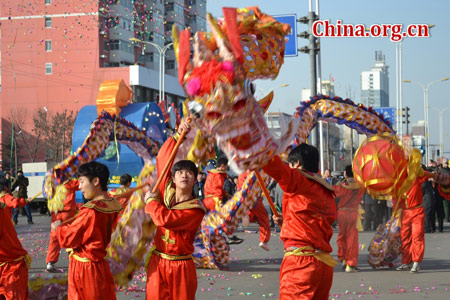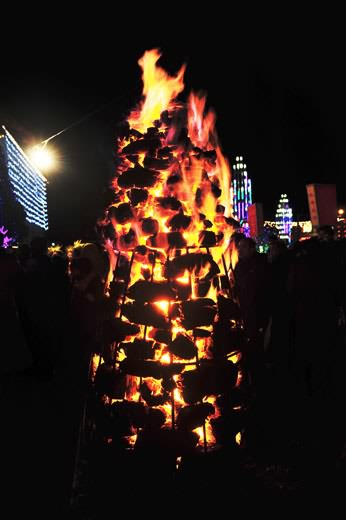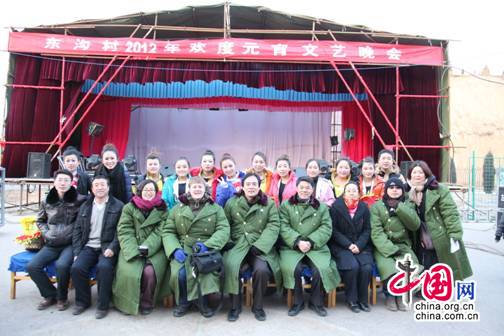Exploring the cultural value of Shanxi's She Huo Festival
- By Lu Cairong
 0 Comment(s)
0 Comment(s) Print
Print E-mail China.org.cn, February 22, 2012
E-mail China.org.cn, February 22, 2012
|
A blazing coal pyre was lit in the city square of Jinzhong City, Shanxi Province, Feb. 6, 2012. [Beijing Review / China.org.cn] |
The night of the Lantern Festival on Feb. 6 in Zuoquan County, part of Jinzhong City in Shanxi Province was bitterly cold, with strong winds blowing through the hilly rural town. But locals stayed warm in front of blazing coal pyres lit in front of their houses. The region's "She Huo" Festival, a Shanxi New Year tradition, had officially started.
An atmosphere of celebration covered the Taihang Mountain range by nightfall as bonfires lit up the evening sky in 33 significant locations in Zuoquan County. More than 50 "She Huo" troupes from villages across county performed alongside the fires, to the cheers and applause of onlookers as well as our visiting team of journalists.
The comfort of fire, the joy of celebration
As popular entertainment, the ancient custom of "She Huo" performances originated in the worship of earth and fire — "She" means "the god of earth", and "Huo" means "the god of fire". Although similar rituals are held in other places in China, especially in the Northwest, the "She Huo" festivities in Shanxi's Jinzhong City area are considered among the most classic and influential. It is reported the first "She Huo" event dates back to the Qin and Han dynasties. "She Huo" traditions further developed in the Tang and Song dynasties and flourished in the Ming and Qing dynasties. With 2,500 years of history, the rich cultural heritage of the She Huo Festival continues into the present day.
Fires, either large or small, are the foundation of "She Huo" festivities. According to Wang Jianjun, the director of Zuoquan County Cultural Bureau, around the time of the traditional Lantern Festival (15th day of the lunar new year) local people pile coal and firewood to form huge pyres. Some households will even build arches made of pine branches and hang multi-colored lanterns.
 |
|
Dragon dancers perform at the annual She Huo Festival in Jinzhong, Shanxi Province in February 2012. [Photo: China.org.cn] |
Zuoquan was named a "Home to Chinese Folk Arts". In all the 204 villages of the county, everyone learns the traditions of folk singing and fire-dancing. There are 129 folk arts groups that can perform lion dancing, singing and martial arts. Zuoquan's local Xiaohua Opera is also a very significant part of the region's intangible cultural heritage. Former late Premier Zhou Enlai once met with the opera performers in Beijing when they won an award for their performance at the country's first National Folk Music & Dance Festival.
Zuoquan's "She Huo" performances have three major forms: Opera, martial arts and clown. Opera "She Huo" is classy, Kung Fu "She Huo" is fierce and the Clown "She Huo" is hilarious. As CIPG journalists team observed on the night of Feb. 7, local villagers performed various acts including traditional ballads, revolutionary songs and new creations of ode to new life. The "She Huo" performances indicated the strong life in the superior cultural traditions, and every performer became a part of the cultural symbol. They are the ones who pass the legacy of the ancient cultural customs from one generation to another with all their sincerity, perseverance and devotion.
Upon nightfall, as the fires were burning wildly, local people (with no regard to age and gender) sing, dance and gather around the fires, which they believe can cast away misfortune. They pray for God's blessing and good fortune in the coming year and express the hopes for the nation and its people.
This year, Zuoquan County revived the folk custom of "touring the fires", which it had not practiced in the last 20 years. "She Huo" teams from surrounding villages performed around fires in various locations. To encourage performers, the county's cultural department offered prize money from 100 to 200 yuan for each team, said Wa Chunfang, the organizer and a vice county mayor. She said the prizes are awarded in respect for the performers' hard work and spirit.








Go to Forum >>0 Comment(s)